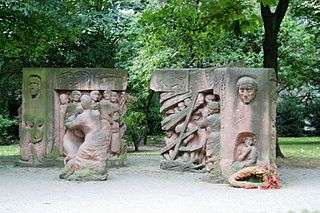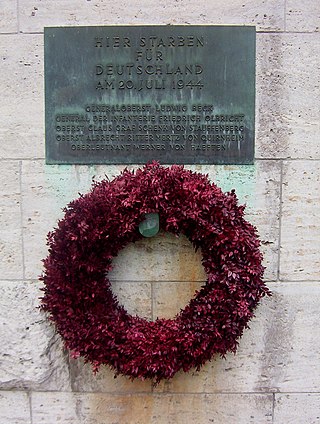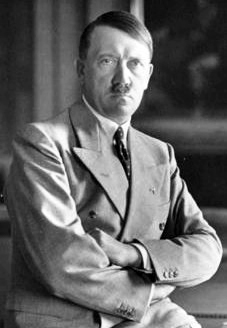Related Research Articles

The Reich Security Main Office was an organization under Heinrich Himmler in his dual capacity as Chef der Deutschen Polizei and Reichsführer-SS, the head of the Nazi Party's Schutzstaffel (SS). The organization's stated duty was to fight all "enemies of the Reich" inside and outside the borders of Nazi Germany.

Louis Leo Snyder was an American scholar, who witnessed first hand the Nazi mass rallies held from 1923 on in Germany; and wrote about them from New York in his Hitlerism: The Iron Fist in Germany published in 1932 under the pseudonym Nordicus. Snyder predicted Adolf Hitler's rise to power, Nazi alliance with Benito Mussolini, and possibly the war upon the French and the Jews. His book was the first publication of the complete NSDAP National Socialist Program in the English language.

Lucy Dawidowicz was an American historian and writer. She wrote books about modern Jewish history, in particular, about the Holocaust.

The Rosenstrasseprotest is considered to be a significant event in German history as it is the only mass public demonstration by Germans in the Third Reich against the deportation of Jews. The protest on Rosenstraße took place in Berlin during February and March 1943. This demonstration was initiated and sustained by the non-Jewish wives and relatives of Jewish men and Mischlinge,. Their husbands had been targeted for deportation, based on the racial policy of Nazi Germany, and detained in the Jewish community house on Rosenstrasse. The protests, which occurred over the course of seven days, continued until the men being held were released by the Gestapo. The protest by the women of the Rosenstrasse led to the release of approximately 1,800 Berlin Jews.

Claudia Ann Koonz is an American historian of Nazi Germany. Koonz's critique of the role of women during the Nazi era, from a feminist perspective, has become a subject of much debate and research in itself. She is a recipient of the PEN New England Award, and a National Book Award finalist. Koonz has appeared on the podcasts Holocaust, hosted by University of California Television, and Real Dictators, hosted by Paul McGann. In the months before the 2020 United States presidential election, Koonz wrote about the risks of autocracy in the United States for History News Network and the New School's Public Seminar.

Many individuals and groups in Germany that were opposed to the Nazi regime engaged in resistance, including assassination attempts on Adolf Hitler or by overthrowing his regime.
Robert Gellately is a Canadian academic and noted authority on the history of modern Europe, particularly during World War II and the Cold War era.

A referendum on merging the posts of Chancellor and President was held in Nazi Germany on 19 August 1934, seventeen days after the death of President Paul von Hindenburg. The German leadership sought to gain approval for Adolf Hitler's assumption of supreme power. The referendum was associated with widespread intimidation of voters, and Hitler used the resultant large "yes" vote to claim public support for his activities as the de facto head of state of Germany. In fact, he had assumed these offices and powers immediately upon Hindenburg's death and used the referendum to legitimise that move and take the title Führer und Reichskanzler.

Parliamentary elections were held in Germany on 29 March 1936. They took the form of a single-question referendum, asking voters whether they approved of the military occupation of the Rhineland and a single party list for the new Reichstag composed exclusively of Nazis and nominally independent 'guests' of the party. Like previous votes in the Nazi era, it was rigged, with a claimed turnout of 99% and 98.8% voting in favour. In a publicity stunt, a number of voters were packed aboard the airships Graf Zeppelin and Hindenburg, which flew above the Rhineland as those aboard cast their ballots.
Nathan Stoltzfus is an American historian and as of 2021 Dorothy and Jonathan Rintels Professor of Holocaust Studies in the history department at Florida State University. He has authored or edited many books.
The Association of German National Jews, colloquially known as the Jews for Hitler, was a German Jewish organization during the Weimar Republic and the early years of Nazi Germany that eventually came out in support of Adolf Hitler.

The propaganda of the Nazi regime that governed Germany from 1933 to 1945 promoted Nazi ideology by demonizing the enemies of the Nazi Party, notably Jews and communists, but also capitalists and intellectuals. It promoted the values asserted by the Nazis, including heroic death, Führerprinzip, Volksgemeinschaft, Blut und Boden and pride in the Germanic Herrenvolk. Propaganda was also used to maintain the cult of personality around Nazi leader Adolf Hitler, and to promote campaigns for eugenics and the annexation of German-speaking areas. After the outbreak of World War II, Nazi propaganda vilified Germany's enemies, notably the United Kingdom, the Soviet Union and the United States, and in 1943 exhorted the population to total war.
Nazism, the common name in English for National Socialism, is the far-right totalitarian political ideology and practices associated with Adolf Hitler and the Nazi Party (NSDAP) in Nazi Germany. During Hitler's rise to power in 1930s Europe, it was frequently referred to as Hitlerism. The later related term "neo-Nazism" is applied to other far-right groups with similar ideas which formed after the Second World War.

A referendum on the Anschluss with Germany was held in German-occupied Austria on 10 April 1938, alongside one in Germany. German troops had already occupied Austria one month earlier, on 12 March 1938. The official result was reported as 99.73% in favour, with a 99.71% turnout.

This is a list of books about Nazi Germany, the state that existed in Germany during the period from 1933 to 1945, when its government was controlled by Adolf Hitler and his National Socialist German Workers' Party. It also includes some important works on the development of Nazi imperial ideology, totalitarianism, German society during the era, the formation of anti-Semitic racial policies, the post-war ramifications of Nazism, along with various conceptual interpretations of the Third Reich.
Theodora Mead Abel (1899–1998) was an American clinical psychologist and educator, who used innovative ideas by combining sociology and psychology. She was a pioneer in cross-cultural psychology.

The Roman Catholic Church suffered persecution in Nazi Germany. The Nazis claimed jurisdiction over all collective and social activity. Clergy were watched closely, and frequently denounced, arrested and sent to Nazi concentration camps. Welfare institutions were interfered with or transferred to state control. Catholic schools, press, trade unions, political parties and youth leagues were eradicated. Anti-Catholic propaganda and "morality" trials were staged. Monasteries and convents were targeted for expropriation. Prominent Catholic lay leaders were murdered, and thousands of Catholic activists were arrested.

Gitel (Gertrude) Poznanski Steed was an American cultural anthropologist known for her research in India 1950–52 involving ethnological work in three villages to study the complex detail of their social structure. She supplemented her research with thousands of ethnological photographs of the individuals and groups studied, the quality of which was recognised by Edward Steichen. She experienced chronic illnesses after her return from the field, but nevertheless completed publications and many lectures but did not survive to finish a book The Human Career in Village India which was to integrate and unify her many-sided studies of human character formation in the cultural/historical context of India.
Hans Meiser was a German Protestant theologian, pastor and from 1933 to 1955 the first 'Landesbischof' of the Evangelical Lutheran Church in Bavaria.
The Crucifix Decrees were part of the Nazi Regime’s efforts to secularize public life. For example, crucifixes throughout public places like schools were to be replaced with the Fuhrer’s picture. The Crucifix Decrees throughout the years of 1935 to 1941 sparked protests against removing crucifixes from traditional places. Protests notably occurred in Oldenburg in 1936, Frankenholz (Saarland) and Frauenberg in 1937, and in Bavaria in 1941. These incidents prompted Nazi party leaders to back away from crucifix removals in 1941.
References
- 1 2 Maier-Katkin, Daniel; Stoltzfus, Nathan; Warren, Sarah R. (20 April 2020). "Why did women vote for Hitler? Long-forgotten essays hold some answers". The Conversation. Retrieved 2020-09-21.
- 1 2 3 "Theodore Fred Abel papers, 1930-1984". Columbia University Libraries Archival Collections. Retrieved 2020-09-21.
- 1 2 Berlin, David Crossland. "Angry Germans 'mimicking' Nazi views". The Times UK. ISSN 0140-0460 . Retrieved 2020-09-21.
- ↑ "Nazis Explain Why They Became Nazis". www.vice.com. 28 February 2018. Retrieved 2020-09-21.
- ↑ Berlin, Derek Scally in. "Why I became a Nazi: New book reveals enthusiasm of early party members". The Irish Times. Retrieved 2020-09-21.
- ↑ "Why German women voted for Hitler, in their own words". Business Insider. Retrieved 2020-09-21.
- ↑ Abel, Theodore Fred (1933). Protestant Home Missions to Catholic Immigrants. Institute of Social and Religious Research.
- ↑ Why Hitler Came into Power — Theodore Abel. www.hup.harvard.edu. Harvard University Press. 8 October 1986. ISBN 9780674952003 . Retrieved 2020-09-21.
- ↑ Abel, Theodore (1986). Why Hitler Came Into Power. Harvard University Press. ISBN 978-0-674-95200-3.
- ↑ Berger, Morroe; Abel, Theodore; Page, Charles H. (1954). Freedom and Control in Modern Society. D. Van Nostrand Company.
- ↑ Abel, Theodore (1965). Systematic Sociology in Germany: A Critical Analysis of Some Attempts to Establish Sociology as an Independent Science. Octagon Books.